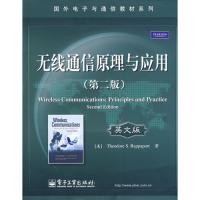| 定價: | ¥ 65 | ||
| 作者: | (美)拉帕波特 著 | ||
| 出版: | 電子工業出版社 | ||
| 書號: | 9787121092312 | ||
| 語言: | 英文原版 | ||
| 日期: | 2009-07-01 | ||
| 版次: | 1 | 頁數: | 707 |
| 開本: | 16開 | 查看: | 0次 |

| 服務商城 | 客服電話 | 配送服務 | 優惠價 | 購買 |
| 400-711-6699 | 滿29至69元,免運費! | ¥52 |
本書是無線通信課程的權威教材,面向那些已經熟悉諸如概率論、通信原理和基本電磁學等技術概念的學生和工程師。全書深入淺出地討論了無線通信技術與系統設計方面的內容,包括無線網絡涉及的所有基本問題,特別是3G系統和無線局域網的問題,并對無線網絡技術新進展和全球主要的無線通信標準給出了論述。全書共分11章,集中講述了蜂窩的概念、移動無線電傳播、調制技術、多址技術以及無線系統與標準,結合理論對無線通信系統的各個方面做了精辟論述和統計分析。
1 Introduction to Wireless Communication Systems
1.1 Evolution of Mobile Radio Communications
1.2 Mobile Radiotelephony in the U.S.
1.3 Mobile Radio Systems Around the World
1.4 Examples of Wireless Communication Systems
1.4.1 Paging Systems
1.4.2 Cordless Telephone Systems
1.4.3 Cellular Telephone Systems
1.4.3.1 How a Cellular Telephone Call is Made
1.4.4 Comparison of Common Wireless Communication Systems
1.5 Trends in Cellular Radio and Personal Communications
1.6 Problems
2 Modern Wireless Communication Systems
2.1 Second Generation (2G) Cellular Networks
2.1.1 Evolution to 2.5G Wireless Networks
2.1.2 Evolution for 2.5G TDMA Standards
2.1.2.1 HSCSD for 2.5G GSM
2.1.2.2 GPRS for 2.5G GSM and IS-136
2.1.2.3 EDGE for 2.5G GSM and IS-136
2.1.3 IS-95B for 2.5G CDMA
2.2 Third Generation (3G) Wireless Networks
2.2.1 3G W-CDMA (UMTS)
2.2.2 3G cdma2000
2.2.3 3G TD-SCDMA
2.3 Wireless Local Loop (WLL) and LMDS
2.4 Wireless Local Area Networks (WLANs)
2.5 Bluetooth and Personal Area Networks (PANs)
2.6 Summary
2.7 Problems
3 The Cellular Concept-System Design Fundamentals
3.1 Introduction
3.2 Frequency Reuse
3.3 Channel Assignment Strategies
3.4 HandoffStrategies
3.4.1 Prioritizing Handoffs
3.4.2 Practical HandoffConsiderations
3.5 Interference and System Capacity
3.5.1 Co-channel Interference and System Capacity
3.5.2 Channel Planning for Wireless Systems
3.5.3 Adjacent Channel Interference
3.5.4 Power Control for Reducing Interference
3.6 Trunking and Grade of Service
3.7 Improving Coverage & Capacity in Cellular Systems
3.7.1 Cell Splitting
3.7.2 Sectoring
3.7.3 Repeaters for Range Extension
3.7.4 A Microcell Zone Concept
3.8 Summary
3.9 Problems
4 Mobile Radio Propagation: Large-Scale Path Loss
4.1 Introduction to Radio Wave Propagation
4.2 Free Space Propagation Model
4.3 Relating Power to Electric Field
4.4 The Three Basic Propagation Mechanisms
4.5 Reflection
4.5.1 Reflection from Dielectrics
4.5.2 Brewster Angle
4.5.3 Reflection from Perfect Conductors
4.6 Ground Reflection (Two-R'ay)Model
4.7 Diffraction
4.7.1 Fresnel Zone Geometry
4.7.2 Knife-edge Diffraction Model
4.7.3 Multiple Knife:edge Diffraction
4.8 Scattering
4.8.1 Radar Cross Section Model
……
5 Mobile Radio Propagation: Small-Scale Fading and Multipatipath
6 Modulation Techniques for Mobile Radio
7 Equalization, Diversity, and Channel Coding
8 Speech Coding
9 Multiple Access Techiques for Wireless Communications
10 Wireless Networking
11 Wireless Systems and Standeads
APPENDICES
INDEX
1.1 Evolution of Mobile Radio Communications
1.2 Mobile Radiotelephony in the U.S.
1.3 Mobile Radio Systems Around the World
1.4 Examples of Wireless Communication Systems
1.4.1 Paging Systems
1.4.2 Cordless Telephone Systems
1.4.3 Cellular Telephone Systems
1.4.3.1 How a Cellular Telephone Call is Made
1.4.4 Comparison of Common Wireless Communication Systems
1.5 Trends in Cellular Radio and Personal Communications
1.6 Problems
2 Modern Wireless Communication Systems
2.1 Second Generation (2G) Cellular Networks
2.1.1 Evolution to 2.5G Wireless Networks
2.1.2 Evolution for 2.5G TDMA Standards
2.1.2.1 HSCSD for 2.5G GSM
2.1.2.2 GPRS for 2.5G GSM and IS-136
2.1.2.3 EDGE for 2.5G GSM and IS-136
2.1.3 IS-95B for 2.5G CDMA
2.2 Third Generation (3G) Wireless Networks
2.2.1 3G W-CDMA (UMTS)
2.2.2 3G cdma2000
2.2.3 3G TD-SCDMA
2.3 Wireless Local Loop (WLL) and LMDS
2.4 Wireless Local Area Networks (WLANs)
2.5 Bluetooth and Personal Area Networks (PANs)
2.6 Summary
2.7 Problems
3 The Cellular Concept-System Design Fundamentals
3.1 Introduction
3.2 Frequency Reuse
3.3 Channel Assignment Strategies
3.4 HandoffStrategies
3.4.1 Prioritizing Handoffs
3.4.2 Practical HandoffConsiderations
3.5 Interference and System Capacity
3.5.1 Co-channel Interference and System Capacity
3.5.2 Channel Planning for Wireless Systems
3.5.3 Adjacent Channel Interference
3.5.4 Power Control for Reducing Interference
3.6 Trunking and Grade of Service
3.7 Improving Coverage & Capacity in Cellular Systems
3.7.1 Cell Splitting
3.7.2 Sectoring
3.7.3 Repeaters for Range Extension
3.7.4 A Microcell Zone Concept
3.8 Summary
3.9 Problems
4 Mobile Radio Propagation: Large-Scale Path Loss
4.1 Introduction to Radio Wave Propagation
4.2 Free Space Propagation Model
4.3 Relating Power to Electric Field
4.4 The Three Basic Propagation Mechanisms
4.5 Reflection
4.5.1 Reflection from Dielectrics
4.5.2 Brewster Angle
4.5.3 Reflection from Perfect Conductors
4.6 Ground Reflection (Two-R'ay)Model
4.7 Diffraction
4.7.1 Fresnel Zone Geometry
4.7.2 Knife-edge Diffraction Model
4.7.3 Multiple Knife:edge Diffraction
4.8 Scattering
4.8.1 Radar Cross Section Model
……
5 Mobile Radio Propagation: Small-Scale Fading and Multipatipath
6 Modulation Techniques for Mobile Radio
7 Equalization, Diversity, and Channel Coding
8 Speech Coding
9 Multiple Access Techiques for Wireless Communications
10 Wireless Networking
11 Wireless Systems and Standeads
APPENDICES
INDEX





 粵公網安備 44030902003195號
粵公網安備 44030902003195號